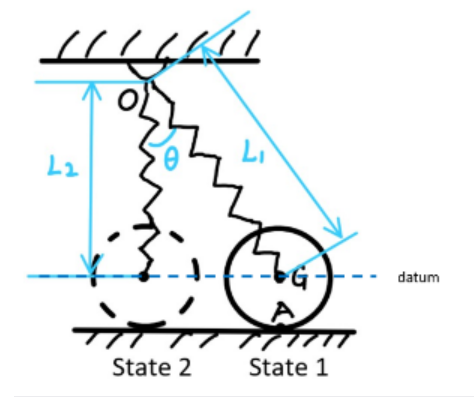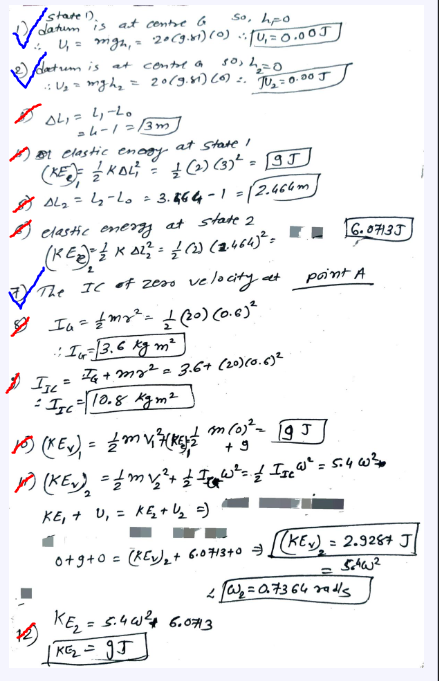The wheel is attached to the spring. The mass of the wheel is m=20 kg. The radius of the wheel is 0.6m. The radius of gyration kG=0.4 m. The spring’s unstretched length is L0=1.0 m. The stiffness coefficient of the spring is k=2.0 N/m. The wheel is released from rest at the state 1 when the angle between the spring and the vertical direction is θ=30°. The wheel rolls without slipping and passes the position at the state 2 when the angle is θ=0°. The spring’s length at the state 2 is L2=4 m.
Simple harmonic motion
Simple harmonic motion is a type of periodic motion in which an object undergoes oscillatory motion. The restoring force exerted by the object exhibiting SHM is proportional to the displacement from the equilibrium position. The force is directed towards the mean position. We see many examples of SHM around us, common ones are the motion of a pendulum, spring and vibration of strings in musical instruments, and so on.
Simple Pendulum
A simple pendulum comprises a heavy mass (called bob) attached to one end of the weightless and flexible string.
Oscillation
In Physics, oscillation means a repetitive motion that happens in a variation with respect to time. There is usually a central value, where the object would be at rest. Additionally, there are two or more positions between which the repetitive motion takes place. In mathematics, oscillations can also be described as vibrations. The most common examples of oscillation that is seen in daily lives include the alternating current (AC) or the motion of a moving pendulum.
Please answer 3, 4, 5, 6, 8, 9, 10, 12
1 is 0, 2 is 0, 7 is point A, 11 is 2.
I included a picture of someone who solved but they were mostly incorrect. Please do not answer if the solution set I provided with the incorrect answers was you. I appreciate the attempt, but the solutions for 3, 4, 5, 6, 8, 9, 10, 12 were marked wrong, so unless you have different answers, please do not submit the same incorrect solution set.
The wheel is attached to the spring. The mass of the wheel is m=20 kg. The radius of the wheel is 0.6m. The radius of gyration kG=0.4 m. The spring’s unstretched length is L0=1.0 m. The stiffness coefficient of the spring is k=2.0 N/m. The wheel is released from rest at the state 1 when the angle between the spring and the vertical direction is θ=30°. The wheel rolls without slipping and passes the position at the state 2 when the angle is θ=0°. The spring’s length at the state 2 is L2=4 m.
(1) If the mass center G is set as the origin (datum), the gravitational potential energy at the state 1 is___ (two decimal places)
(2) If the mass center G is set as the origin (datum), the gravitational potential energy at the state 2 is___ (two decimal places)
(3) The stretched spring length of the spring at the state 1 is________(m) (two decimal places)
(4) The elastic potential energy at the potion 1 is_______(N·m) (two decimal places)
(5) The stretched spring length of the spring at the state 2 is _______(m) (two decimal places)
(6) The elastic potential energy the state 2 is ___ (N·m ) (two decimal places)
(7) The instantaneous center of zero velocity (IC) is
(8) The mass moment of inertial about the mass center G is IG =_________(kg·m2 ) (two decimal places)
(9) The mass moment of inertial about the IC center is IIC =_________(kg·m2 ) (two decimal places)
(10) The kinetic energy at the state1?________ (N·m) (two decimal places)
(11) The
(12) The kinetic energy at the state 2?______ (N·m) (two decimal places)


Trending now
This is a popular solution!
Step by step
Solved in 2 steps with 1 images

The only incorrect one was 12. It says based on the answer for 11 (which is 2), find the KE at state 2. Would it be 13.10 - 2 = 11.1?








